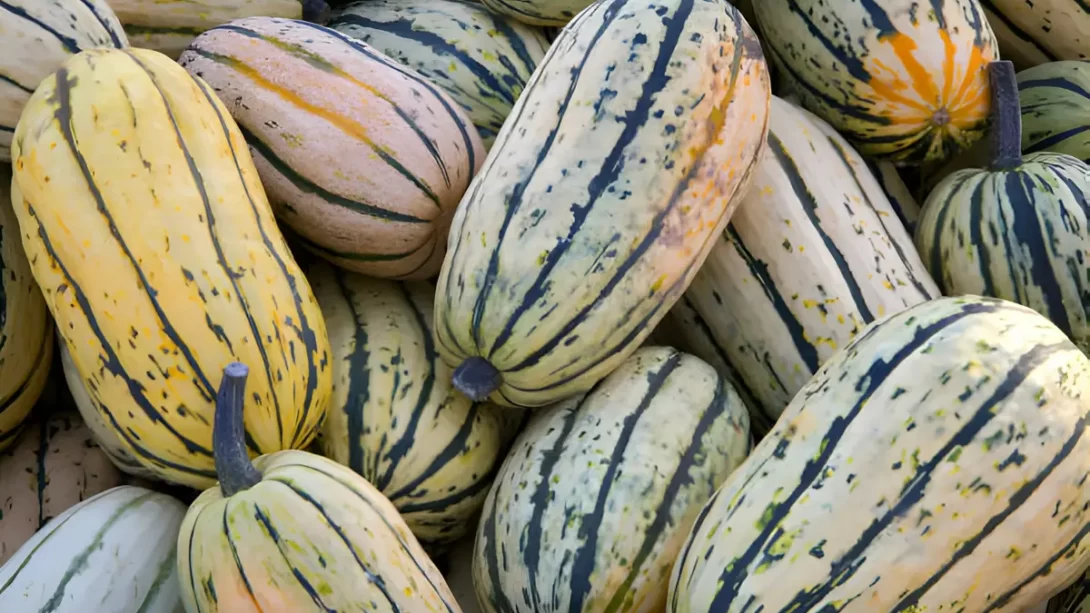Delicata squash, known for its distinctive oblong shape and striped, creamy skin, is a favorite among winter squashes for its sweet, nutty flavor and ease of preparation. Unlike some of its hardier cousins, Delicata squash has a tender skin that is edible when cooked. A successful harvest of this squash not only depends on proper cultivation but also on precise timing for picking. Harvesting at the right moment ensures the best flavor and texture, and it also plays a crucial role in the squash’s storage life.
The Growth Cycle of Delicata Squash
The journey of Delicata squash from seed to fruit is fascinating. It starts with germination, followed by vine development, flowering, and finally, fruiting. The entire cycle can be influenced by factors like climate, soil quality, and regular care. Typically, the stages are:
- Germination: This initial stage occurs quickly, often within a week of planting.
- Vine Development: The plant’s vines start to grow and spread, a phase that requires ample space and sunlight.
- Flowering: Delicata squash produces yellow flowers, which then develop into fruits.
- Fruiting: The squash grows from the base of the flower, gradually maturing over time.
Each stage is crucial, and understanding them helps in monitoring the plant’s health and development.
Identifying Maturity in Delicata Squash
Knowing when Delicata squash is ready to harvest is key. As the fruit matures, it undergoes several changes:
- Size: A mature Delicata squash is typically about 7-9 inches in length.
- Color: Look for a change in skin color. A ripe Delicata squash usually has a creamy background with green or orange stripes.
- Rind Texture: The skin should harden as the squash matures. A good test is to try and pierce the rind with your fingernail; a mature squash will resist puncture.
Another indicator is the condition of the stem. As the squash ripens, the stem begins to wither and turn brown. This change in the stem is a reliable sign that the squash is ready for harvest.
Optimal Time for Harvesting Delicata Squash
Generally, Delicata squash takes between 80 to 100 days from planting to reach maturity. However, this timeline can vary based on local weather conditions. Cooler climates may slow the maturation process, while warmer regions might speed it up.
It’s important to pay attention to the weather when deciding to harvest. If an early frost is forecasted, it’s usually wise to harvest the squash, as frost can damage the skin and reduce the storage life. On the other hand, leaving the squash on the vine too long, especially in wet conditions, can lead to rotting or overripening.
Harvesting Techniques for Delicata Squash
Harvesting Delicata squash properly is crucial for maintaining its quality. When you’ve determined that the squash is ripe, use a sharp knife or pruning shears to cut it from the vine. It’s important to leave a few inches of the stem attached to the squash; a stem that is too short can hasten spoilage. Be careful not to bruise or damage the squash during harvesting, as any injury can become a site for rot during storage.
Handle the squash gently after cutting it from the vine. Although the rind is hard, it can still be susceptible to bruising or punctures. Transport the squash carefully to your storage or preparation area, avoiding dropping or piling them on top of one another.
Post-Harvest Handling and Curing
After harvesting, Delicata squash benefits from a curing period. Curing helps to harden the skin further and can enhance the squash’s flavor and storage life. To cure Delicata squash:
- Place the harvested squash in a warm, well-ventilated area. A temperature of around 25°C (77°F) is ideal.
- Leave the squash in this environment for about 7 to 10 days.
- Make sure to turn the squash occasionally so that all sides are exposed to air.
Once cured, inspect each squash for any signs of damage or decay. If you find any, use these first, as they won’t store as well as the undamaged ones.
Storage Tips for Delicata Squash
Proper storage is key to enjoying Delicata squash throughout the season. Store the cured squash in a cool, dry place with good air circulation. Ideal storage conditions are at temperatures of 10°C to 15°C (50°F to 59°F) with a relative humidity of 50-70%. Under these conditions, Delicata squash can typically be stored for about 3 to 6 months.
Check the stored squash periodically for signs of spoilage, such as soft spots or mold. If you notice any issues, use these squashes immediately to prevent them from affecting others.
Troubleshooting Common Issues in Growing and Harvesting
Growing Delicata squash can sometimes present challenges, but understanding these issues can lead to a more successful harvest. Common problems include pest infestations, diseases, and environmental stressors.
- Pests: Squash bugs and vine borers are common pests that can damage Delicata squash. Regular monitoring and organic pest control methods can help keep these pests at bay.
- Diseases: Powdery mildew and bacterial wilt are diseases to watch out for. These can be mitigated by ensuring proper plant spacing for air circulation and practicing crop rotation.
- Environmental Stress: Inconsistent watering can lead to issues like blossom end rot or splitting. Maintain a regular watering schedule, especially during dry spells.
If you notice the leaves turning yellow or the vine wilting, it might indicate a nutrient deficiency or a disease. Adjusting your fertilization routine or using organic fungicides can often remedy these problems.
Adjusting Growing Conditions
To ensure a healthy Delicata squash crop:
- Soil Quality: Ensure your soil is rich in organic matter and well-draining. Squash prefers a slightly acidic to neutral soil pH.
- Watering: Provide consistent moisture, especially during the flowering and fruiting stages. Avoid overwatering to prevent root rot.
- Sunlight: Delicata squash thrives in full sunlight. Ensure your plants get at least 6 hours of direct sunlight daily for optimal growth.
Conclusion
Harvesting Delicata squash at the right time is crucial for enjoying its sweet, creamy flavor. By understanding the signs of maturity, using proper harvesting techniques, and caring for the squash post-harvest, you can extend the shelf life and enjoy these delightful squashes throughout the season. Remember, regular monitoring and adjusting growing conditions can greatly impact the health and yield of your Delicata squash. With patience and care, you can enjoy the fruits of your labor and the unique taste and texture that Delicata squash brings to your culinary creations. Happy gardening!




